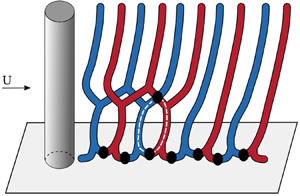Article contents
Cellular vortex shedding from a cylinder at low Reynolds number
Published online by Cambridge University Press: 18 March 2021
Abstract

Flow past a cylinder in the presence of side walls is investigated numerically for various combinations of Reynolds numbers ( $50 \leqslant \textit {Re} \leqslant 100$) and aspect ratio (
$50 \leqslant \textit {Re} \leqslant 100$) and aspect ratio ( $5 \leqslant AR \leqslant 90$). Various attributes such as cellular shedding, dislocations, oblique angle of vortices and their structure near the end wall are studied. The complexity of the transitions in the wake, with
$5 \leqslant AR \leqslant 90$). Various attributes such as cellular shedding, dislocations, oblique angle of vortices and their structure near the end wall are studied. The complexity of the transitions in the wake, with  $\textit {Re}$, increases with increase in
$\textit {Re}$, increases with increase in  $AR$. The flow is associated with a single cell wake for
$AR$. The flow is associated with a single cell wake for  $AR=20$, at all the
$AR=20$, at all the  $\textit {Re}$ considered. For
$\textit {Re}$ considered. For  $AR$
$AR$ $=90$ the flow transitions from a one-cell to two-cell wake at
$=90$ the flow transitions from a one-cell to two-cell wake at  $\textit {Re} \sim 50$, to a four-cell structure at
$\textit {Re} \sim 50$, to a four-cell structure at  $\textit {Re} \sim 55$ to a three-cell wake at
$\textit {Re} \sim 55$ to a three-cell wake at  $\textit {Re} \sim 58$, and then to a two-cell wake at
$\textit {Re} \sim 58$, and then to a two-cell wake at  $\textit {Re} \sim 61$. The vortices near the end wall diffuse for
$\textit {Re} \sim 61$. The vortices near the end wall diffuse for  $Re\leqslant 58$ whereas linkages form between adjacent vortices of opposite polarity at larger
$Re\leqslant 58$ whereas linkages form between adjacent vortices of opposite polarity at larger  $Re$. The frequency of dislocations increases with increase in
$Re$. The frequency of dislocations increases with increase in  $\textit {Re}$. Two types of dislocations have been identified: the fork type at relatively low Re and connected fork type at larger Re. Linkages between vortices in connected fork-type dislocations may lead to ring-like structures. The end conditions and nonlinear mechanisms play a significant role in the evolution of cellular shedding. A single cell across the span is the dominant mode of shedding in the linear regime. Compared with the linear analysis, nonlinearities result in smaller oblique angles, higher shedding frequency and larger streamwise speed of the convection of vortices.
$\textit {Re}$. Two types of dislocations have been identified: the fork type at relatively low Re and connected fork type at larger Re. Linkages between vortices in connected fork-type dislocations may lead to ring-like structures. The end conditions and nonlinear mechanisms play a significant role in the evolution of cellular shedding. A single cell across the span is the dominant mode of shedding in the linear regime. Compared with the linear analysis, nonlinearities result in smaller oblique angles, higher shedding frequency and larger streamwise speed of the convection of vortices.
JFM classification
- Type
- JFM Papers
- Information
- Copyright
- © The Author(s), 2021. Published by Cambridge University Press
References
REFERENCES
- 14
- Cited by



